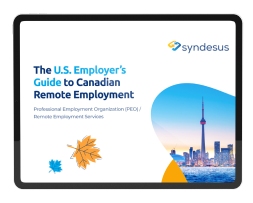Last year, 47.4 million workers voluntarily quit their jobs in the US. These record-breaking numbers led Texas A&M psychologist Anthony Klotz to coin the term the “Great Resignation” back in May 2021. And with 10.9 million open jobs at the end of July, unsatisfied workers know they have options to quit and find something new.
For many US employers, the stress of retaining unsatisfied employees is compounded by H-1B visa woes.
Sure, the annual limit of 85,000 H-1B visas may seem like a high number, but demand overwhelms supply. US employers filed more than 300,000 registrations for H-1B selection for the fiscal year 2022.
…there’s still no guarantee that your H-1B employee will make the final cut.
Under the Trump administration, the denial rate soared to 24% in the fiscal year 2018 and remained high at 21% in the fiscal year 2019, and 13% in the fiscal year 2020. After four Trump administration years, President Biden’s first year in office saw a record low in the denial rate of H-1B visa petitions, according to an analysis of government data. During the fiscal year 2021, the denial rate for new H-1B employment petitions dropped to 4%.
A 4% rejection rate is a huge improvement on 24%, but there’s still no guarantee that your H-1B employee will make the final cut.
Employers are understandably feeling the heat. They’re working to retain workers amid the Great Resignation, and they’re facing uncertainty about whether or not their foreign workers will get the H-1B visas they need to work in the US.
So, what happens if you lose foreign talent to the H-1B process? Here’s what you need to know about the true cost of replacing an employee and how Canada’s alternatives to the H-1B visa can help.
Replacing a single employee is costing your company more than you think
Once you add up the cost of recruiting and training, hiring a new employee will cost you much more than their salary.
…the average training expenditures for midsize companies increased from $808,355 in 2020 to $1.3 million in 2021
The Society for Human Resource Management estimated that companies spend an average of 42 days to fill a position and $4,129 per hire on top of their salary, benefits, and more.
Advertising the job and hiring a recruiter are just the first costs you’ll tally in your hunt for workers, but training is one of the costliest investments a company can make.
According to a recent study by Training Magazine, the average training expenditures for midsize companies increased from $808,355 in 2020 to $1.3 million in 2021.
In addition to all the money spent on training employees, companies also invest time and effort.
According to that same study by Training Magazine, employees received nearly 64 hours of training per year in 2021, compared to 55.4 hours in 2020.
Lastly, but most importantly, there is the emotional effort that goes into bringing a new employee into the fold. It takes time, effort, and emotional intelligence to place a new employee on the right team of peers and ensure they’re thriving in their new role.
That’s why holding onto current employees is such a priority.
The Great Resignation has workers demanding more from their employers
To keep workers from heading for the exit and to attract new hires, employers are rethinking their work policies and management styles.
People returning to the workforce after the pandemic are expecting more from their employers, including salary increases, bonuses, and improved benefit plans, but they also want more opportunities at work.
LinkedIn’s 2019 Workforce Learning Report found that 94% of employees want employer-funded learning opportunities and over a quarter (27%) of Gen Z and Millennials say the number one reason they’d leave their job is if they did not have enough learning and growth opportunities.
A PwC study also revealed that Millennials prefer personal learning and development benefits over financial rewards. Millennials also value feedback from their management. In a global survey conducted in 2014 with Oxford Economics, 1,400 Millennials admitted they value feedback, and they want it 50% more often than Gen X or Baby Boomers.
Why all the millennial-focused research? In the workforce today, millennials outnumber all other generations, and economists say that millennials will represent 75% of the global workforce by 2025.
Tellingly, a survey by Employment Hero found that people aged 25-34 are the most fed up with work, with 77% looking to change roles within the next year.
When you compound the issue of retaining top talent with those surrounding the US immigration system, especially the H-1B visa, you get the need for alternative solutions that help retain top talent and can avoid US immigration pitfalls.
Canada is one of those solutions – specifically, Canada’s Global Talent Stream.
US companies can hire in Canada using a PEO and completely avoid the H-1B program
Global Talent Stream (GTS) — part of Canada’s Global Skills Strategy — empowers Canadian employers to speed up the process of hiring skilled foreign workers to fill specialized jobs. In less than two weeks you can get authorization to work in Canada through GTS, which is hands down Canada’s fastest immigration pathway for workers.
The Global Talent Stream is a popular immigration pathway for two main reasons: expedited processing means that workers can have a work permit in approximately 10 days, and the program is an excellent pathway to permanent immigration to Canada.
To be eligible, you must have a job offer from a Canadian employer that is seeking workers for a unique, specialized, or high-skilled and in-demand occupation that can be found on a Global Talent Occupations List – a list that is updated frequently.
The Global Talent Stream is a popular immigration pathway for two main reasons: expedited processing means that workers can have a work permit in approximately 10 days, and the program is an excellent pathway to permanent immigration to Canada. You only need one year of Canadian work experience to qualify for permanent residency.
Using GTS to hire top talent may be easy for companies with an office in Canada, but for the majority of US companies that don’t have a Canadian presence, can you still take advantage of Canada’s GTS program?
The answer is a resounding yes.
And the way you do that is with a Canadian PEO.
A professional employer organization (PEO) — like Syndesus — enables a US-based company to remotely hire international professionals abroad (in this example, in Canada). Legally, the PEO hires the employee and keeps them on the PEO’s Canadian payroll.
The PEO handles all the technical aspects of employment like handing out paychecks, managing employee benefits, payroll, HR, and more. This way the employer can focus on the day-to-day management of their employees while the PEO handles all the nitty-gritty details.
The company still controls the employee’s day-to-day responsibilities, pays their salary, can offer stock options or other benefits, and more. Essentially, it’s as if the US company had an office in Canada.
It’s a win for the company since they hire or retain a key employee with an expiring visa. And it’s a win for the individual who may be fatigued from the H-1B lottery or wants to avoid it altogether.
Let Syndesus help you hire the talent you need in Canada and avoid the H-1B lottery process
As a PEO, Syndesus can hire your current, or prospective, US employee in Canada on behalf of your company if you don’t have a legal presence in Canada.
As mentioned above, Syndesus takes care of the immigration, billing, HR, legal and other paperwork, and, once approved, the employee can move to Canada and keep working!
Reach out to us to learn more about how we help US companies keep skilled tech workers by moving them up to Canada.
And if you’re a tech worker in the US and you’re looking to move to Canada and work for a Canadian company, join our Path to Canada database to get matched with a Canadian employer looking for tech talent and willing to sponsor your Canadian work visa.






